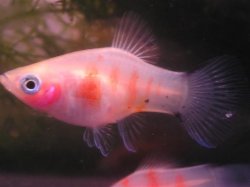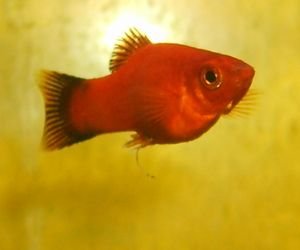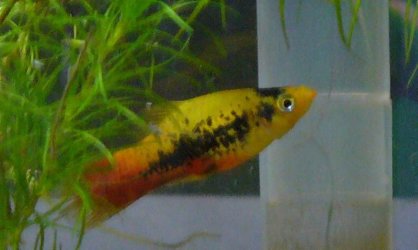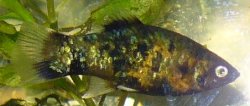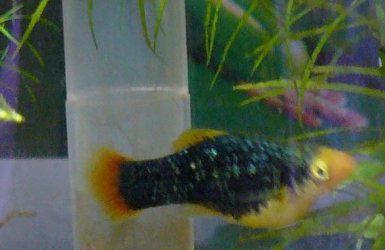FrankSlapperinni
Fish Herder
Platy
Common name: Platy, sometimes variatus or southern platy.
Origin: North Eastern Central America
Size: 2 - 2½ in. (5 - 6.25 cm.)
Scientific Name: Xiphophorus maculatus and Xiphophorus variatus
Family oeciliidae
oeciliidae
Care: Platys are very easy to care for, and are great beginner fish. Platy's prefer water temperature at 76-79F ( 24.4-26.1C). Platy's are very hardy, and can adapt to many types of water. PH can rage from acidic (6.5) to basic (8.2). Platy's have even been reported to live in brackish water (lightly salted water) and experience no negative effects of it.
Diet: Flake, frozen, freeze dried, and live food is all accepted by the Platy, and all should be fed to them on a rotating basis. Although flake can be their staple diet, it will keep them more healthy to feed varying food, and help them show better colors. Fry (baby fish) will also be consumed by the Platy and company.
Sexing: There are many ways to sex a Platy (these sexing methods, by the way, can be applied to all livebearers), but there are two that are more widely used than others. The first method is to observe the shape of the Platy, Females will be longer, and also have wider stomachs (even when not pregnant) than males. The second method (and most accurate) involves observing the three fins on the underbelly of the fish. Female Platy's will have three almost identical fins, two a little further up the belly (closer to the front) than the rear, and with a male, the two frontal fins will be the same, but the aft fin will be much smaller, and pointed.
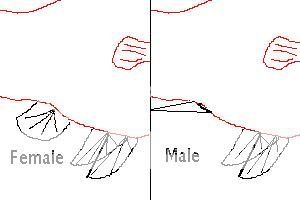
Breeding: Breeding Platy's is said to be exceptionally easy, because the caretaker of the fish has to do nothing to start it, and usually can do nothing to prevent it. Platy's, like all other livebearers (Molly's, Guppy's, Swordtail's, and Mosquito Fish) give birth to live young, and do not lay eggs, so for a period of time, the fish is actually pregnant. Gestation usually lasts about a month, at which point the fry are released from the mother, and usually shortly thereafter are eaten by the mother and other platys. Determining whether a Platy is pregnant, like sexing, is not hard to do. If she exhibits one or all of the following signs, she is most likely pregnant.
1. She is much fatter than you remember her, and seems about ready to explode
2. She has a black spot that was not there before forming above the three fins used to determine the sex (this spot is called a gravid spot, and is said to be the eyes of developing fry)
3. She is a Platy
Caring for fry, like everything else about the Platy, is also exceptionally easy. If you would like a large brood (batch, litter, etc.) of fry, it is best to isolate the mother in a breeding net (purchasable at almost any Local Fish Store (LFS)) or even a separate tank, but make sure to do so before she is giving birth or close to it, or she will abort the babies and reabsorb them. There are many liquid foods and such out there and to feed baby fish, but Platy's are not demanding, and therefor flake food crushed into tiny pieces will do. Feed in the morning and at night, and feed small amounts.
Platies can, and will hybridize with Swordtails too.
Comments: Platy's are a very hardy fish, and are good beginner fish, but are in no way limited to those who have just started keeping fish. They have a very inquisitive personality, and will explore all levels of the tank. Platys have a wide range of colors, including red, orange, yellow, white, black, and blue, with many different combinations of the colors. They can be found at almost any LFS, and are one of the cheapest fish available.

Common name: Platy, sometimes variatus or southern platy.
Origin: North Eastern Central America
Size: 2 - 2½ in. (5 - 6.25 cm.)
Scientific Name: Xiphophorus maculatus and Xiphophorus variatus
Family
Care: Platys are very easy to care for, and are great beginner fish. Platy's prefer water temperature at 76-79F ( 24.4-26.1C). Platy's are very hardy, and can adapt to many types of water. PH can rage from acidic (6.5) to basic (8.2). Platy's have even been reported to live in brackish water (lightly salted water) and experience no negative effects of it.
Diet: Flake, frozen, freeze dried, and live food is all accepted by the Platy, and all should be fed to them on a rotating basis. Although flake can be their staple diet, it will keep them more healthy to feed varying food, and help them show better colors. Fry (baby fish) will also be consumed by the Platy and company.
Sexing: There are many ways to sex a Platy (these sexing methods, by the way, can be applied to all livebearers), but there are two that are more widely used than others. The first method is to observe the shape of the Platy, Females will be longer, and also have wider stomachs (even when not pregnant) than males. The second method (and most accurate) involves observing the three fins on the underbelly of the fish. Female Platy's will have three almost identical fins, two a little further up the belly (closer to the front) than the rear, and with a male, the two frontal fins will be the same, but the aft fin will be much smaller, and pointed.

Breeding: Breeding Platy's is said to be exceptionally easy, because the caretaker of the fish has to do nothing to start it, and usually can do nothing to prevent it. Platy's, like all other livebearers (Molly's, Guppy's, Swordtail's, and Mosquito Fish) give birth to live young, and do not lay eggs, so for a period of time, the fish is actually pregnant. Gestation usually lasts about a month, at which point the fry are released from the mother, and usually shortly thereafter are eaten by the mother and other platys. Determining whether a Platy is pregnant, like sexing, is not hard to do. If she exhibits one or all of the following signs, she is most likely pregnant.
1. She is much fatter than you remember her, and seems about ready to explode
2. She has a black spot that was not there before forming above the three fins used to determine the sex (this spot is called a gravid spot, and is said to be the eyes of developing fry)
3. She is a Platy
Caring for fry, like everything else about the Platy, is also exceptionally easy. If you would like a large brood (batch, litter, etc.) of fry, it is best to isolate the mother in a breeding net (purchasable at almost any Local Fish Store (LFS)) or even a separate tank, but make sure to do so before she is giving birth or close to it, or she will abort the babies and reabsorb them. There are many liquid foods and such out there and to feed baby fish, but Platy's are not demanding, and therefor flake food crushed into tiny pieces will do. Feed in the morning and at night, and feed small amounts.
Platies can, and will hybridize with Swordtails too.
Comments: Platy's are a very hardy fish, and are good beginner fish, but are in no way limited to those who have just started keeping fish. They have a very inquisitive personality, and will explore all levels of the tank. Platys have a wide range of colors, including red, orange, yellow, white, black, and blue, with many different combinations of the colors. They can be found at almost any LFS, and are one of the cheapest fish available.



